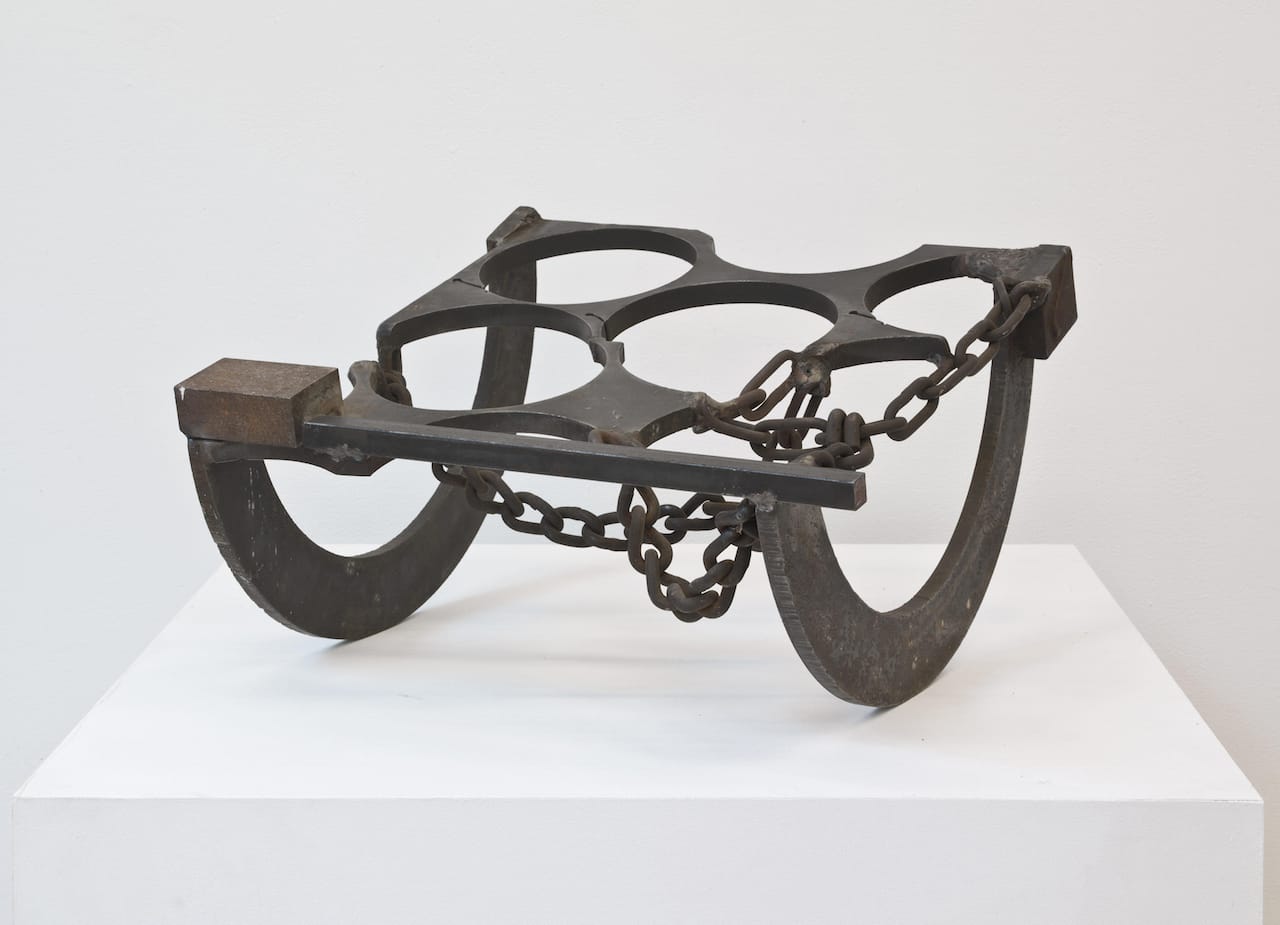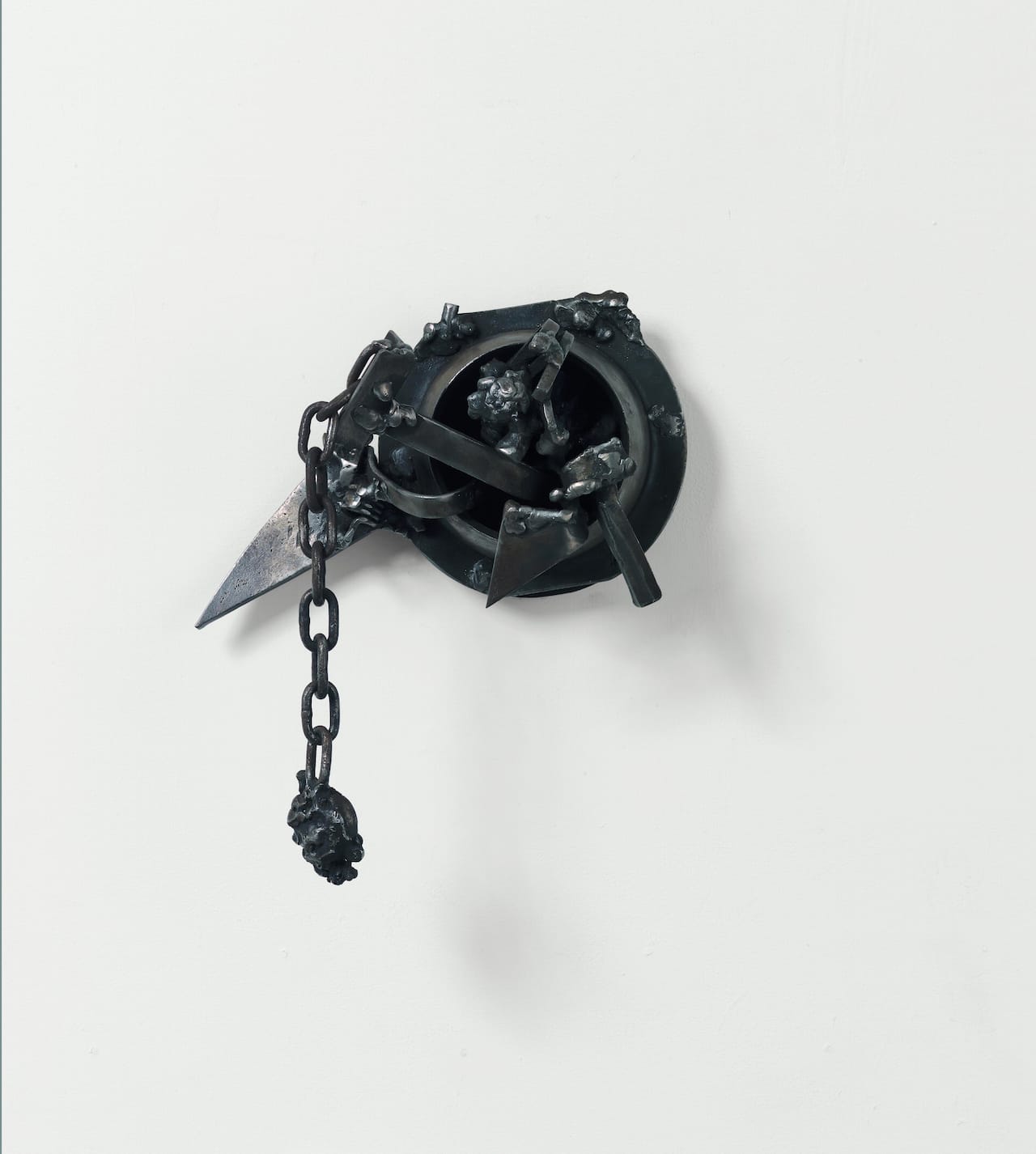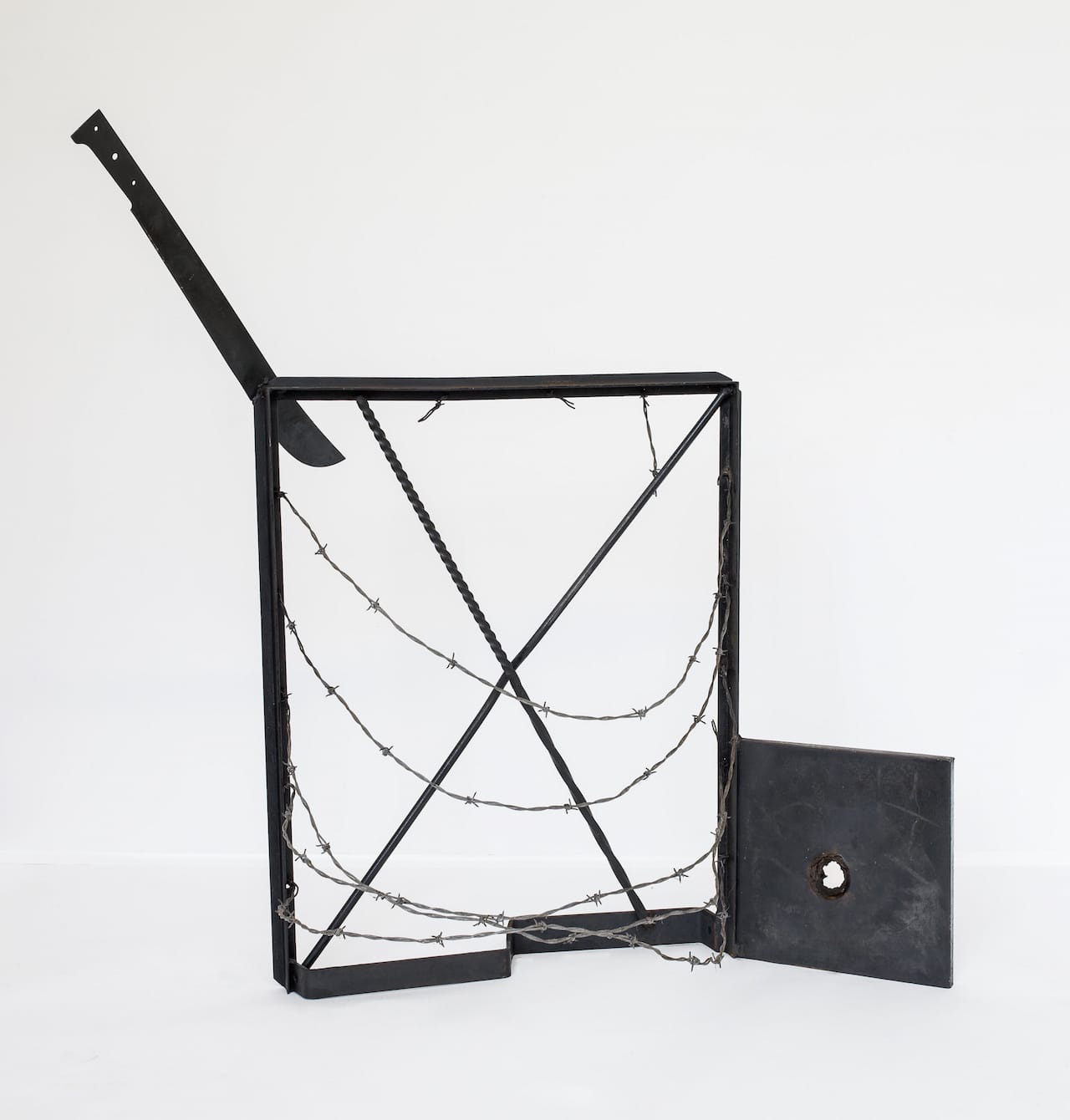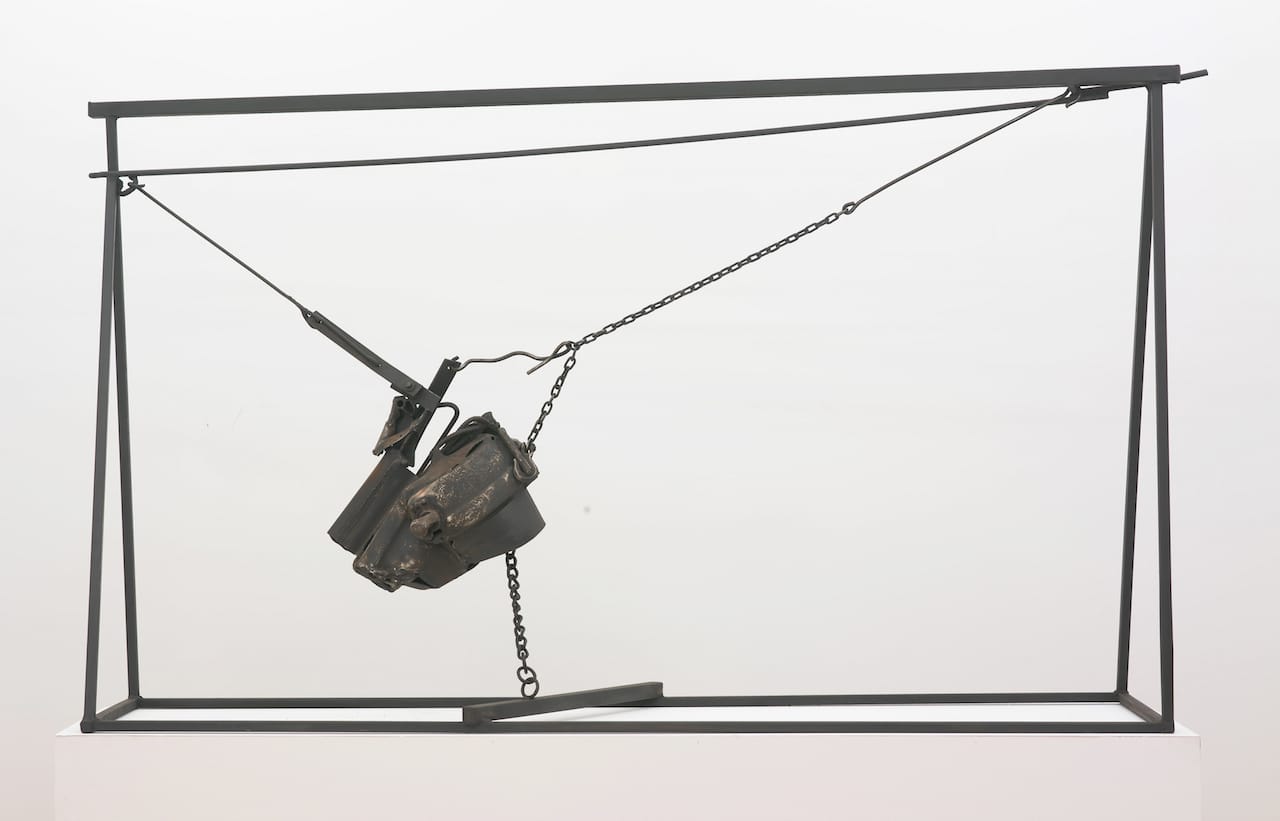Will Some Bright Morning Ever Arrive?
NEW BRUNSWICK, NJ — In 1963, while living in Los Angeles, Melvin Edwards welded “Some Bright Morning” out of different pieces of steel scrap metal, including a heavy chain and a dagger-like fragment extending from a circular, collar-like form.

NEW BRUNSWICK, NJ — In 1963, while living in Los Angeles, Melvin Edwards welded “Some Bright Morning” out of different pieces of steel scrap metal, including a heavy chain and a dagger-like fragment extending from a circular, collar-like form. By using scrap metal, Edwards took a different path from his peers, who were making assemblages out of junk. Although he might not have been aware of it at the time, Edwards was both aligning himself with the use of welding and iron that began with Julio Gonzalez and Pablo Picasso, and continued in the work of David Smith and Anthony Caro. However, it seems to me that once this lineage became apparent, he recognized his desire to open it to a history that included blacksmithing, slavery, and the physical pain inflicted by the use of metal instruments.
In an interview with Michael Brenson that is part of “BOMB’s Oral History [documenting] the life stories of New York City’s African American artists,” Edwards made two statements about his sculptures that seem important to mention here:
I just didn’t want them stuck in formalist criticism; I wanted to make you think about why I made the work. For me, the whole thing about modern art is, you can invent your own game and all the rules. It’s just a matter of, does it come out vital as work? That’s the kind of thing that allowed me to think broadly even though it looks like I’m working narrowly.
One of my discussions within the black art community was with people who said, “Abstraction can’t be black.” Well, I don’t know why not. It always was. Besides, we do new and experimental stuff with music, with any number of other things. Why not with art? I realized I was talking to people who hadn’t played with those thoughts much. A lot of people were culturally progressive, but they were rooted in the politics of social realism, coming out of the ’30s, and they figured, well, if you’re going to be black and radical, it ought to be a certain way. I said, “It’s fine if it is that way, but there are other ways to develop it.” That was all in that early ’60s period where we did discuss these things and pass them around. We were very happy with Charlie Parker and that whole bebop music period because it showed that a black movement could be comprehensive in the world in terms of its creativity. It’s a totally modern music, but at the same time, it does have a history of the particular culture that it comes from.
Edwards would go on to make many welded-steel wall pieces, which he collectively titled “Lynch Fragments,” at various periods of his career, a selection of which are included in the revelatory exhibition at the Zimmerli Art Museum, Melvin Edwards: Five Decades (September 1, 2015 – January 10, 2016).

The “Lynch Fragments” are always meant to be mounted sixty inches from the floor to the artwork’s midpoint, which is the sculptor’s eye level. Edwards wanted that direct face-to-face confrontation. Although his early pieces, particularly with regard to the “Lynch Fragments,” seem to have been influenced by the tools and other functional objects used by David Smith in his sculpture, “Home of the Welder” (1945), this was not the case. Edwards did not learn of Smith’s work until after he developed an approach that incorporated functional objects, such as bolts, padlocks, rebar, scissors, collars, and wrenches. Moreover, the objects that Smith contextualized were imbued with a different cultural history from the ones that Edwards incorporated into his work.
Born in Houston, Texas, in 1937, Edwards grew into adulthood in an America where segregation was still the law in many states. We should not confuse Smith’s use of tongs or a printer’s tray with Edwards’ use of a chain or padlock. These elements are derived from America’s troubled and troubling history; Edwards calls attention to this history but never becomes didactic about it, which is what gives his work an undeniable power. More than half-century later, the early “Lynch Fragments” have lost none of their power. In fact, they have gained in resonance over time because they point to the physical pain and constraints that humans have had to endure throughout history. The power of Edwards’ sculpture is consummately sensual, not in the erotic sense, but one that suggests deep, wrenching pain.
For his exhibition at the Zimmerli, which originated at the Nasher Sculpture Center in Dallas, Texas, where Catherine Craft brilliantly curated it, Edwards once again reprises his one-person show at the Whitney Museum of American Art in 1970, the first solo in that museum’s history by an African American sculptor. At the Zimmerli, Edwards installed his barbed wire sculptures across different galleries and areas, which did not lessen their visceral impact. In “Corner for Ana” (1970), he formed a triangular prism by stretching the lengths of barbed wire across a corner.

As with “Some Bright Morning,” the title “Corner for Ana,” who is Edward’s eldest daughter, pushes back against any reductive reading, defying the Minimalist credo as famously summed up by Frank Stella: “What you see is what you see.” In his use of titles addressed to family, friends, musicians, and other artists, such as Wifredo Lam, Edwards shares something with other African American artists, particularly Jack Whitten, Stanley Whitney, Martin Puryear and Jean-Michel Basquiat. That something is a sense of history and community – both real and imagined – which is largely invisible to mainstream society.

Language may not be transparent, as Ludwig Wittgenstein pointed out, but neither is it neutral. By incorporating tools into his work, and addressing friends and others in his titles, Edwards was reappropriating and recontextualizing objects and language, reminding us that nothing is pure, and the goal of purity in art is a privileged viewpoint that denies cultural difference.
In the diversity of works included in this exhibition, from the “Lynch Fragments” to the barbed wire and planar sculptures to the maquettes for public works, it is obvious that Edwards is a major artist who defined his own path. Edwards refused to become a Minimalist and work in a purist, reductive vein, which makes him an important figure in the counter tradition that refuting the widely accepted narrative that claims that sculpture culminated in Minimalist objects before moving on to an expanded field. It is a tradition that includes Isamu Noguchi, Ruth Asawa, and Martin Puryear, all of whom were committed to making their own work, and not withdrawing the hand. This refusal to accept art’s dominant, mainstream language regarding materials and methods is an area of study that needs to be further explored.

In his interview with Brenson, which I cited earlier, Edwards talks about two museum shows devoted to his work. In 1965, he had his first one-person museum exhibition at the Santa Barbara Art Museum. He was not yet thirty and still living in California. In 1967, he moved to New York where he had his show at the Whitney Museum of America three years later. Contrary to what one might think, Edwards sold none of the work included in either exhibition and received no offers to show with a gallery. Despite such indifference, Edwards expresses no anger when he recounting these events to Brenson. Rather, recognizing the state of things, he points out that he had to make sure that he was gainfully employed. I cannot think of another artist who has acted as graciously and stoically under such disappointing circumstances. The strength of his subsequent work is a testament to the grit and imagination of this indomitable artist.
Melvin Edwards: Five Decades continues at the Zimmerli Art Museum (71 Hamilton Street, New Brunswick, New Jersey) through January 10, 2016.




